China spinning a ‘web’ of influence campaigns to win over Taiwan
Away from the headline grabbing military threats, Beijing’s propaganda department is working to woo hearts and minds.
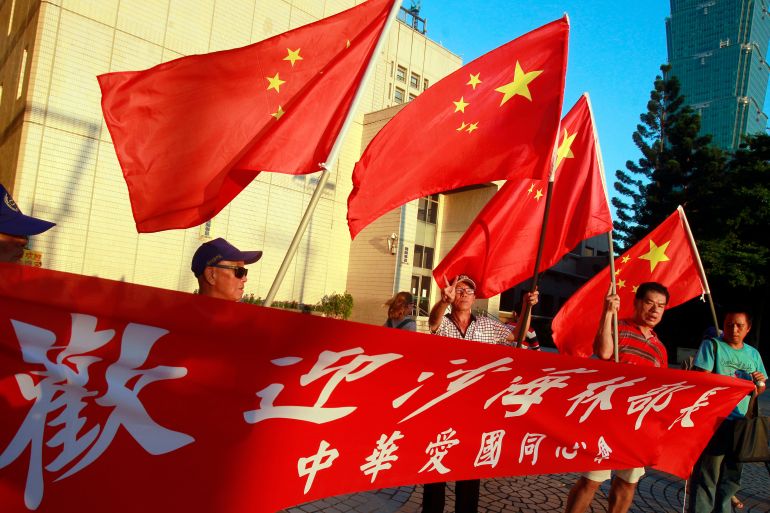
Taipei, Taiwan – Squeezed against apartment blocks deep in New Taipei City, the Guanghe Fude Temple, dedicated to the earth god Tudigong, seems like a typical Taoist shrine.
The small house-like structure has marble walls, a tiled roof adorned with dragons and a ticker-tape LED sign – a common addition – protecting an interior of wood-carved reliefs, a sand-filled urn for josh sticks and a more fire-safe wall of electric candles. Then, there is Tudigong himself, wearing a bright gold and red sash.
Keep reading
list of 4 itemsSouth Africa top court hears case questioning Zuma’s electoral eligibility
Key takeaways from Xi Jinping’s European tour to France, Serbia and Hungary
‘We have no option’: An election protest brews in Indian coffee capital
But Taiwan’s media has alleged the temple is associated with China’s United Front Work Department, a Chinese Communist Party (CCP) agency that leads a wide-reaching influence campaign to “win friends and influence people”.
Speaking to Al Jazeera on a brief tour of the temple, Liang Tsu-wei, the temple committee’s honorary chairman, says the media have it slightly wrong. He insists that while he is a member of the United Front and Taiwan’s fringe pro-China Unionist Party, the temple is neutral ground.
While Liang says he would one day like to see the peaceful reunification of China and Taiwan, he engages in mostly small-scale political activities. “We have a lot of demonstrations and protests against the Democratic Progressive Party government,” he said. “If we think their policies are wrong, we will mobilise thousands of people to demonstrate and protest. But it’s up to [them] to decide whether or not to go.”
By Liang’s telling, the United Front and Unionist Party sound like any other political group active in a democratic society and temples like Guanghe Fude simply offer a casual setting for neighbours to chat and get to know each other.
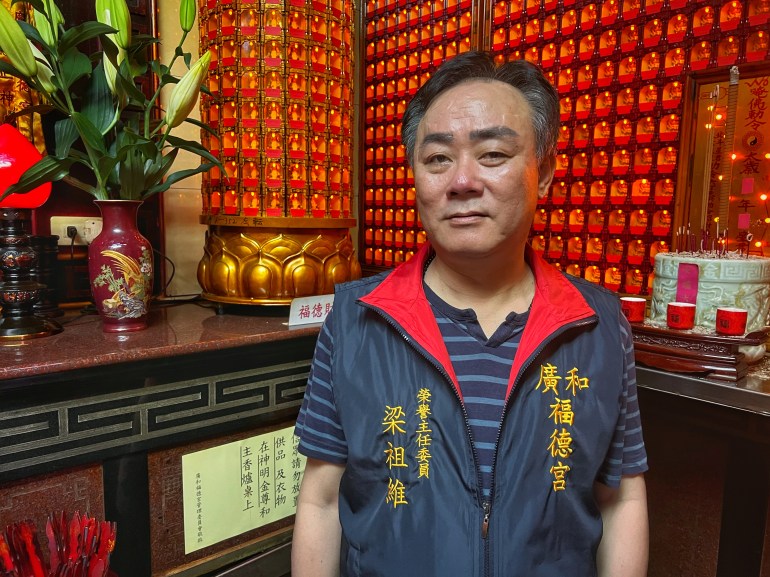
But there are also plenty of people, like political scientists and experts in Chinese politics, who see the activity of such groups another way: as a second subversive front in Chinese President Xi Jinping’s campaign to achieve “reunification” and “liberate” democratic Taiwan’s 23 million people by peace or by force by 2049 – the deadline for China’s “national rejuvenation“.
Carrot and stick
The CCP has pledged to take control of Taiwan ever since the Chinese nationalists set up their government on the island after losing China’s Civil War in 1949.
The United Front offers many of the carrots to the headline-grabbing sticks – sanctions, diplomatic isolation and overt threats – of the People’s Liberation Army (PLA), China’s principal military force. This dual strategy exists because, despite China’s superior military power, an attack on Taiwan would still carry a great cost to Beijing because it would probably drag in the United States, Taiwan’s main security guarantor.
Worse, if the CCP were to achieve anything less than total victory, it could spell regime change. Convincing Taiwan to come willingly and avoid a devastating war would be a “win-win” for Beijing.
“For Xi and the CCP, peaceful unification with Taiwan is the best plan. They also know peaceful reunification will not work if they withdraw PLA’s military actions against Taiwan. That’s why Xi and the CCP never renounce the right to use force,” said Kuan-chen Lee, an assistant research fellow at Taiwan’s Institute for National Defense and Security Research (INSDR).
The overall strategy focuses on “changing the perceptions of the Taiwanese people”, Lee said by email. “It attempts to deepen Taiwanese people’s understanding that (1) reunification has advantages; (2) Taiwan independence is a dead end; (3) outsiders cannot be relied on. In other words, the CCP’s priority of pursuing reunification is to sow the seeds of peaceful unification among the people of Taiwan, rather than a full-scale invasion.”
United Front activity comes in many forms, some directed by the United Front Work Department office in Beijing, but sometimes through less formal channels, says John Dotson, deputy director of the Global Taiwan Institute and an expert in Chinese propaganda.
The United Front works openly through “peaceful reunification” groups in Taiwan and abroad, many of which can be traced to the United Front’s China Council for the Promotion of Peaceful National Reunification. Groups like these and the Unionist Party often take part in “cultural exchanges” with the CCP through group trips to the mainland.
There are also well-known ties between temples in Taiwan and China, particularly those dedicated to the Buddhist-Taoist deity Mazu – the goddess of the sea – and through underworld criminal activity.
Not all of this work is a positive pan-cultural movement, says Gerry Groot, a senior lecturer and expert on the United Front at Australia’s University of Adelaide.
“While United Front work is often presented as winning friends to the Communist Party, the other side of the coin is to delegitimise and isolate enemies in order to destroy them,” he said. “In this case, it’s to win over people in Taiwan to support unification as well as to delegitimise the idea of independence and the notion of Taiwan as any sort of independent entity – and that applies not only to Taiwan but internationally.”
Past United Front campaigns also focused on Taiwan’s “three middles”: the middle and lower class, people in middle and southern Taiwan, and middle to smaller businesses, according to Puma Shen, an expert in Chinese misinformation campaigns and chairperson of Taiwan’s Double Think Lab.
More recently, it has shifted to “grassroots groups” like local elites and leaders as well as younger people under 30, he said, describing its work as a “spiderweb” of influence campaigns.
Celebrities and business people hoping to make it big in China’s far larger market may also end up stumping, sometimes very directly, for the Communist Party and its “One China” vision. Taiwan’s highly partisan media landscape is another major target.
In 2019, an investigation by the United Kingdom’s Financial Times alleged WantWant Holdings, a Taiwanese multinational that owns the pro-Beijing China Times newspaper and the TV stations China Television and Chung T’ien Television (CiTV), had close ties to the CCP as well as Beijing’s Taiwan Affairs Office and was receiving subsidies from China.
The company denied the allegations but the next year, CiTV lost its broadcasting licence after being accused of spreading Chinese disinformation.
Nostalgia for China
One of the United Front’s best-known targets is its historic enemy the Kuomintang (KMT), according to some analysts.
The KMT led China’s early republican government and has been at odds with the Communist Party since its founding in Shanghai in 1921. The two sides fought against each other at various points until the KMT fled to Taiwan in the 1940s, taking 2 million people with them and stepping in for the Japanese colonial government that had ruled Taiwan for half a century.
Unfortunately, it is the KMT’s nostalgia for its former homeland that is its weak spot, says Groot.
“[The KMT’s] attachment to this idea of Greater China is so strong, that despite the fact that historically, they were the victims of the success of the United Front work, they see this idea of Greater China as greater than themselves,” he told Al Jazeera. “And they’re, once again, willing to align themselves with Communist Party goals, because that’s the only way that unification is going to be achieved in their mind.”
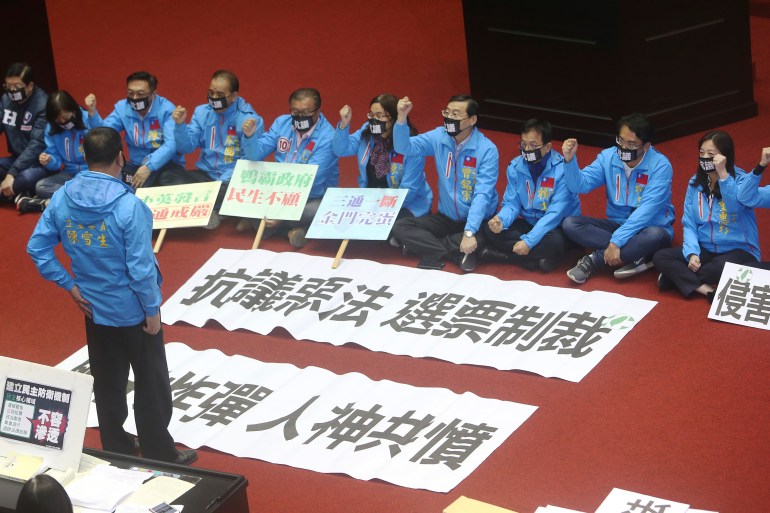
The same was once true of much of elite Taiwanese society, dominated for decades by families who fled with the KMT and still felt a deep connection to China.
But now, the associations are fading.
Over the past 20 years, Taiwanese increasingly see themselves as either “Taiwanese” or “Taiwanese-Chinese” instead of “Chinese”, according to long-term polling by National Chengchi University, which has sharply changed the political narrative.
KMT leaders, however, continue to hold regular meetings with Communist Party officials, including a recent landmark trip by former President Ma Ying-jeou this year who became the first Taiwanese leader – in or out of office – to visit China since the 1940s.
For the KMT, visiting Beijing is important to keep the lines of communication open during downturns in the relationship between Beijing and Taipei, such as since the 2016 election of President Tsai Ing-wen of the Democratic Progressive Party (DPP), with both dismissed by Beijing as “separatists”. Tsai says the people of Taiwan are the only ones who can decide their future.
Party members, like Tso Chen-dong, director of the party’s Mainland Affairs Department, reject concerns they are susceptible to CCP influence.
“It is not that the KMT is open to CCP’s influence, I think we should put this equation in the other direction,” Tso said. “It is the case that the KMT still hopes to influence the CCP’s future policies through dialogue and social interaction so that the status quo can be maintained and the cross-strait relations can be stabilised… I believe the DPP is also trying to do that but the difference is how much success they achieve.”
Even so, the United Front is enough of a concern to all of Taiwan’s political parties for the legislature in 2019 to have passed an anti-infiltration act in response to intensified “United Front work to divide and infiltrate Taiwan” in a threat to its “security, social order, and normal functioning of democratic politics”. The law criminalises giving political donations, canvassing, lobbying, disrupting rallies, or spreading disinformation on behalf of “hostile external forces”, for example, Beijing.
Taiwan’s government has a formidable foe in the United Front.
While the organisation is not actively staging military exercises in the Taiwan Strait, its activities are wide-reaching and more discreet than overt displays of military strength.
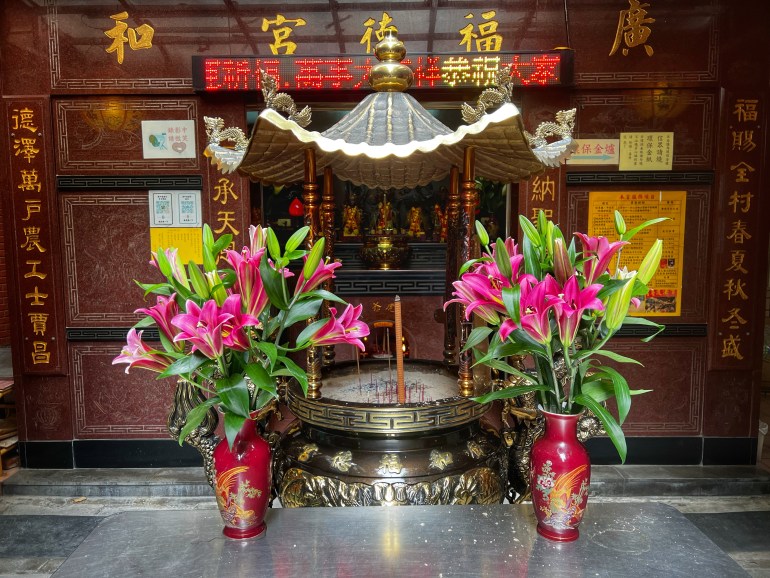
Some of its work is coordinated from the United Front Work Department in Beijing but much of it is also decentralised, according to Groot.
Every Communist Party committee has its own United Front subcommittee, as does the military and other major organisations, all working towards a common cause. Groot estimates there are “enormous numbers” of people inside and outside China working on United Front efforts, although official numbers and its budget are not public.
The Heritage Foundation, a conservative US think tank known for its hawkish views on China, estimated in 2020 that the United Front could employ as many as 40,000 people. Double Think’s Shen estimates it could be as many as 600,000, factoring in the fact that all national, provincial and local members of the Chinese People’s Political Consultative Conference could be mobilised to carry out United Front work.
Since taking power in 2012, Chinese President Xi has expanded the work of the organisation, while also raising the salary and prestige of department employees.
United Front is an “all-Party effort”, said John Dotson, deputy director of the Global Taiwan Institute and an expert in Chinese propaganda. He said it is comparable to “astroturfing” or the practice of creating fake organisations and causes to sway public opinion or surreptitiously promote a certain lobbying effort.
The United Front, similarly, may work abroad through foreign exchange groups, embassies, overseas Chinese organisations and even legislators in foreign countries to promote Beijing’s agenda.
Since 2019, the CCP’s propaganda about Taiwan has grown even louder, with declarations that “reunification” is an essential and “inevitable” part of national rejuvenation, according to Dotson, as it continues to spend “considerable effort trying to conduct covert politician influence operations” there.
Whether or not they will succeed, though, is another question.
People like Guanghe Fude Temple chairman Liang are increasingly rare in Taiwan as most Taiwanese do not want to see “reunification” any time soon or at all, according to repeated polling.
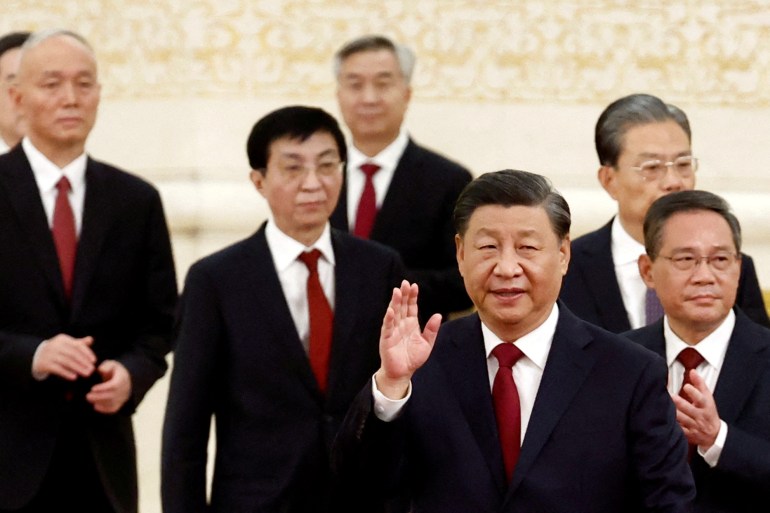
They also reject Beijing’s longstanding plan for how to make it happen – the “one country, two systems” that was tried in Hong Kong after its 1997 handover and collapsed by 2020.
There are some tremors within the CCP suggesting that a change could be afoot, said GTI’s Dotson. At the CCP’s “Taiwan Work Conference” last month, party official Wang Huning, who oversees United Front policy, appeared to play down “one country, two systems” in favour of another formula titled The Party’s Comprehensive Plan for Resolving the Taiwan Problem in the New Era.
Analysts say this could signal a potential change in the CCP’s “ideological framework” towards Taiwan and one day, an updated “reunification” model, but predicting anything more concrete is impossible at the moment.
In the meantime, the carrot and stick policy will continue as Taiwan can neither stop the PLA from sending daily air force sorties across the Taiwan Strait nor stop its citizens from visiting China or engaging in free speech online. At the end of the year, they will also be able to choose their next president and whether they want a pro-independence leader or one who wants to court Beijing.
“It’s very tricky because Taiwan is a democratic country and the government can’t prohibit mobility rights. We’re worried that visits and exchanges become the CCP’s United Front work,” said INSDR’s Lee. “I think the Chinese government should normalise cross-strait exchanges without political purposes. At the same time, I think those who visit China should be really careful of not falling into the trap of United Front work.”